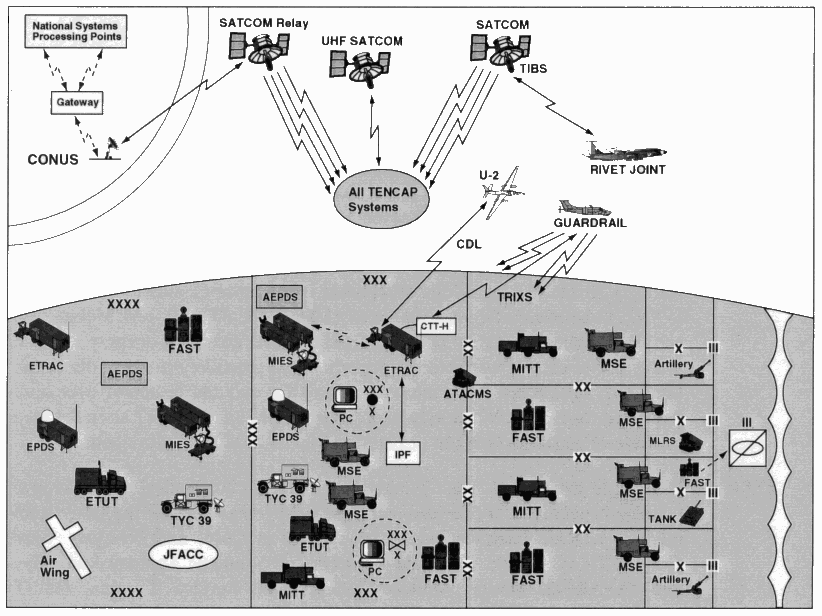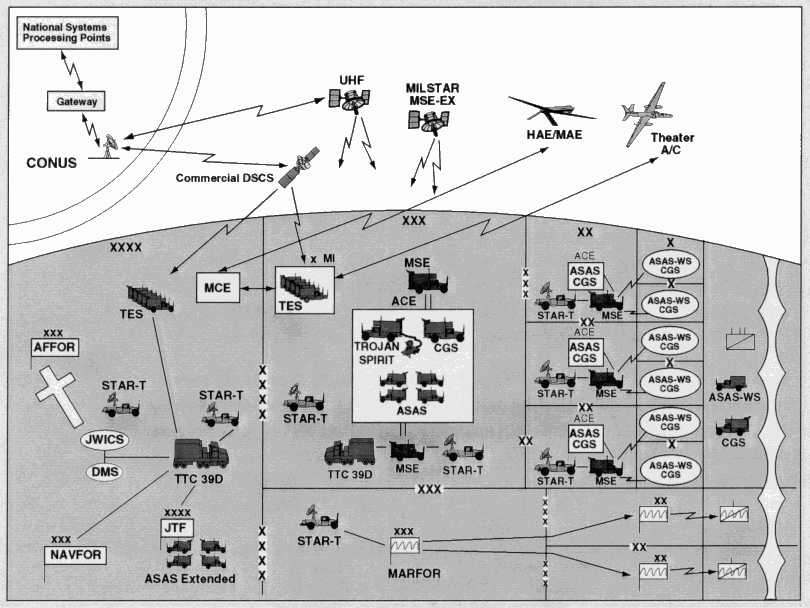

ARMY TENCAP MASTER PLAN
MAY 1995
Chapter 2
Requirements & Operational Concepts
Broad Requirements
Space has become an integral component of the Army's technological and operational evolution. Army space activities include efforts to maintain the technological edge, to use research and development for gaining more leverage from national investments in space systems, and to influence the design of future space systems. The Army has established the principle of Capitalization of Space Based Assets as part of the Army Enterprise Strategy.
Army space policy consists of three primary goals:
This vision comprises the highest level of requirements instituted by the Army with regard to space. To accomplish this space vision, the Army is developing concepts, identifying and documenting specific requirements, and beginning to train a cadre of space experts.
The cornerstones of Army TENCAP activities will continue to be based on warfighterrequirements for space applications, specifically TENCAP support to weapons systems, employment tactics, and theater battle management.
A sampling of broad requirements which are envisioned to drive mid- and longterm Army TENCAP efforts includes:
The Army intends to support initiatives which satisfy not only common user requirements like those included in the list above, but also Army unique requirements for space.
The TENCAP program is unique in that its goal is to leverage assets which were originally designed to meet strategic requirements for meeting the tactical requirements of the soldier on the ground. Downlinking of strategic systems to tactical levels, is limited in depth of coverage. It does, however, provide an accurate and current enemy picture (imagery, communications, and electronic signatures) during both planning and execution, and provides true assured receipt within required timelines
Space applications and TENCAP requirements are derived from two Requirements Paths. In the first mode, which is the source level, validated requirements from operational commands (e.g. Operational Requirements Documents (ORD), Mission Needs Statement (MNS), Statements of Need (SON), Mission Area Analysis (MAA), or Mission Area Plan (MAP) are continuously reviewed, or are presented by the originating command for assessment regarding Army TENCAP support. Some examples applicable to Army TENCAP include "Material Need for Army Tactical Requirements for National Level Reconnaissance" (14 Mar 73) and the MNS, "Assured Receipt of Imagery for Tactical Forces" (2 Jul 90). In the second path of requirements identification, assigned staff members continuously review technology developments and national systems capabilities to identify potential "fits" to known warfighter needs.
Concept of Operations
TENCAP systems, communications, and processors for SIGINT and IMINT data receive intelligence data from a mix of national and airborne reconnaissance assets at the national, theater, and tactical levels. Tactical reconnaissance, though valuable at all levels, is limited in depth of coverage. It provides timely, critical, detailed information needed by corps commanders and below. Theater reconnaissance is medium-to-high-resolution coverage encompassing the area of responsibility of tactical units and deeper in support of Unified, Joint Task Force (JTF) or major component commanders. National assets are responsible for collection throughout the Unified Commander's area of responsibility, particularly beyond the capability of theater-assigned reconnaissance resources. National systems provide the first reconnaissance available to a force entering a hostile area.
The concept for employing Army TENCAP is to field systems that are responsive to the unique needs of the commander throughout the spectrum of conflict, from peacetime through crisis, war, and redeployment. In addition, the concept must support Operations Other Than War (OOTW), to include natural disasters, humanitarian relief, and other efforts as required.
Army TENCAP systems are fundamental assets throughout the spectrum of conflict, specifically supporting the following operations:
The Army will use space capabilities
to enhance the execution of its doctrine. The unique capabilities derived from space systems enhance the Army's warfighting ability to achieve land force dominance at each level of war: strategic, operational, and tactical. At these levels of war, the specific intent for the use of space systems can be viewed in terms of global projection (look for indicators) at the strategic level, theater projection (focus limited) at the operational level, and ground projection (full application of resources to a particular event or region) at the tactical level. Land force operations will be regional in nature; possibly in strange areas; on short notice; with joint, combined, or coalition forces; and in concert with other Agencies of Govemment. In addition, the Army will likely be a smaller force with more and varied missions, all in the midst of increasing uncertainty. Only space systems can provide global, continuous, and near-continuous coverage and connectivity to allow the Army to execute its mission effectively. They are particularly important where the operational area lacks the infrastructure to support Army operations and where the US has limited or no forward presence.( I ) Strategic Level.
At the strategic level of war (global projection), space capabilities are used primarily to reduce the National Command Authorities' (NCAs) uncertainties and to support the combatant commander's requirements for executing our national security policy. Space systems provide missile launch detection; navigation; weather; communications and intelligence; and tipoffs that help strategic planners and decisionmakers design theater campaigns, define limits, and assess risks. In addition, planners and decisionmakers are able to choose courses of action for using the other elements of our national power to resolve: political, diplomatic, economic, information, and military problems, so that national and strategic objectives are secured.(2) Operational Level.
At the operational level of war (theater projection)-in addition to those capabilities listed above-space systems provide data on enemy force size, location, and movements; and improve battle command, greater situational awareness, and remote sensingto the theater/JTF commander, functional component commander, and theater/campaign planners. These capabilities most directly augment and influence decisions during the planning, execution, and support of major land campaigns.
(3) Tactical Level.
At the tactical level (ground projection), national systems can provide real time and near-real-time support to the combat, combat support, and combat service support forces that execute battles and engagements on a nonlinear battlefield (i.e. close, deep, and rear operations). During combat, national systems provide real time position and navigation data (with accuracy unavailable from terrestrial sources); near real-time surveillance and warning of enemy locations, activities and strength; current and projected weather information; terrain and hydrographic information, as well as other conditions of the battle space; and both internal and external communications to enhance the synchronization of close, deep, and rear operations. Seeing deep disrupts the enemy's tempo and the effectiveness of follow-on operations. National systems provide targeting information needed to support deep operations. National systems can provide a more robust battle management command, control, communication, computers, and intelligence architecture (BMC4I) in conduct of theater missile defense (TMD) at the tactical level, as well as at the operational and strategic levels. In addition, they provide an opportunity to reduce the need for man-in-the-loop by streamlining the sensor-to-shooter linkage process. Most importantly, national systems play a complementary role with conventional intelligence systems to provide tactical commanders with critical data.National systems are capable of providing worldwide surveillance and reconnaissance and can satisfy many predeployment intelligence requirements. While these systems are controlled at the national level, Army forces can receive this information through the TENCAP program. TENCAP provides Army commanders with high-leverage equipment that can receive, process, correlate, exploit and disseminate data provided by national systems. Initially, equipment such as the Digital Imagery Test Bed (DITB) and Interim Tactical Electronic Processor (ITEP), were developed for corps utilization. Through preplanned product improvement (P3I) and technology insertion, systems were modernized and downsized to field at Echelons Above Corps (EAC), corps, and Echelons Corps and Below (ECB). These systems include the Modernized Imagery Exploitation System (MIES), Enhanced Tactical Radar Correlator (ETRAC), Electronic Processing and Dissemination System (EPDS), Advanced Electronic Processing and Dissemination System (AEPDS), Enhanced Tactical Users' Terminal (ETUT), Mobile Integrated Tactical Terminal (MITT), and Forward Area Support Terminal (FAST). Redistribution to other units can be done in accordance with mission requirements. Factors affecting these decisions vary according to the nature of the command, the priority and timeliness of the requested information, and the type of intelligence requested (e.g. imagery and signals).
As discussed previously, Army TENCAP systems receive data from various reconnaissance assets. Figure 2-1 illustrates the current architecture connectivity for manned airborne and national systems with Army TENCAP systems. Figure 2-2 depicts the architecture connectivity of the future and includes unmanned as well as manned airborne systems.

Figure 2-1: Current Architecture Connectivity

Figure 2-2: Future Architecture Connectivity
MIES
MIES is a mobile imagery exploitation and dissemination system used at the corps and EAC levels which communicates with Enhanced Tactical Users Terminal (ETUT), Enhanced Tactical Radar Correlator (ETRAC), and national systems via the following interfaces: Tri-band SATCOM Subsystem (TSS) (X, C, Ku), UHF SATCOM and line of sight (LOS) via Synthesized UHF Computer-Controlled Equipment Subsystem (SUCCESS) radio, Secret Internet Protocol Router Network (SIPRNET) and Joint Worldwide Intelligence Communication System (JWICS), Automatic Digital Network (AUTODIN), STU III, and Mobile Subscriber Equipment (MSE). MIES can perform host database, imagery received! archive, exploitation management, reporting and secondary imagery dissemination. MIES has a six- hour setup/teardown time and can be towed over semiimproved roads. The MIES system is transportable via C-5/C-17 aircraft (driveon/drive-off capable) or it can be palletized for C- 1 30/C- 141 movement.
ETRAC
ETRAC is the Army's latest generation of systems for tactical exploitation of national capabilities. It provides real time radar image data for the Corps commander. ETRAC interfaces with various units at Corps and Echelons Above Corps. ETRAC interfaces include the Advanced Synthetic Aperture Radar System (ASARS-2) sensor, Modular Interoperable Surface Terminal (MIST) antenna, UHF SATCOM and LOS via SUCCESS radio, AUTODIN, STU III, and GUARDRAIL. TRAP and TIBS through CTT/H radio are planned. ETRAC is used for mission planning, host database, imagery receivedlarchive, reporting,
and secondary imagery dissemination. This system can be driven on or offC-130 or larger aircraft.ETUT
The ETUT system is used to correlate and integrate data for analysis and rapid reporting of target data. It is integrated with the other TENCAP systems with UHF SATCOM and LOS via SUCCESS radio, MSE, AUTODIN, STU III/Fax, Tactical Receive Equipment and Related Applications (TRAP), Tactical Information Broadcast Service (TIBS), and Tactical Onboard Processing System (TOPS). It can be transported on C-130/C-141 (palletized) and drive on/drive off C-5/C17 aircraft.
EPDS
The Electronic Processing and Dissemination System (EPDS) system receives and processes raw data from selected national sensors, stores processed data, and produces Tactical ELINT (TACELINT) reports in support of U.S. Army Corps commanders. The EPDS system interfaces with the GUARDRAIL system for SIGINT information. The system can also communicate via UHF SATCOM and LOS using SUCCESS radio.
MITT
The Mobile Integrated Tactical Terminal (MITT) system is a division and corps level mobile, system capable of providing multiple source SIGINT and IMINT to Army tactical forces. As a downsized version of the ETUT, MITT provides timely integrated intelligence products to the tactical commander. MITT is equipped with the SUCCESS radio for stand-alone secure communications. The communications system processor is compatible with TROJAN, MSE, AUTODIN/Defense Special Security Communications System (DIN/DSSCS), TRAP, TIBS, and other TENCAP systems. Airborne transport is available via C-130/141 (drive-on/drive-off) aircraft.
FAST
The FAST system is a smaller version of MITT, supporting Echelons Above Corps (EAC), corps, divisions and Armored Cavalry Regiments (ACRs) in providing intelligence data processing at the collateral level. Weighing approximately 1200 pounds (two main workstations, and one remote subsystem), FAST is transported via six transit cases on a variety of vehicles and aircraft. FAST is compatible with TROJAN, MSE, DIN/DSSCS, TRAP /Tactical Data Information Exchange Service-Broadcast (TADIXS-B), TIBS, and other TENCAP systems.